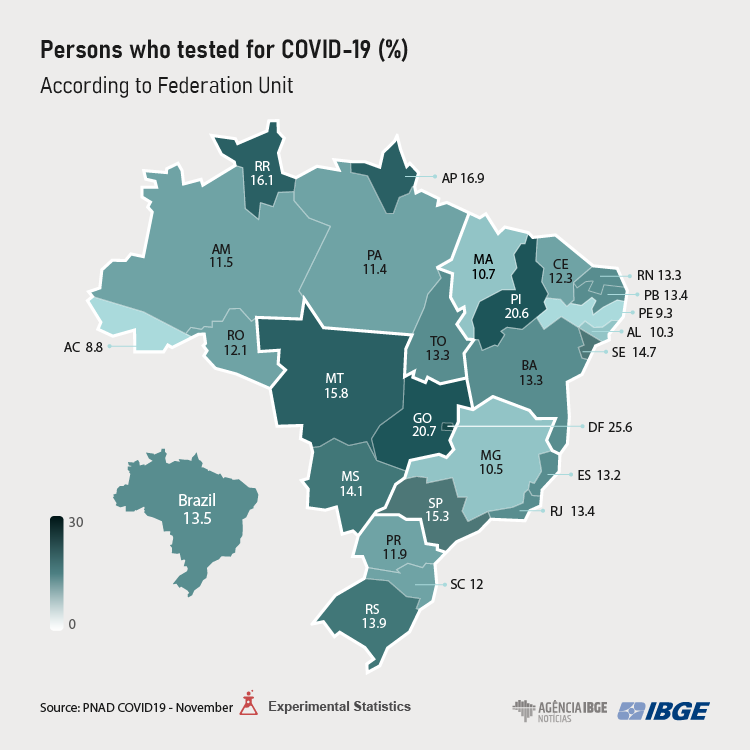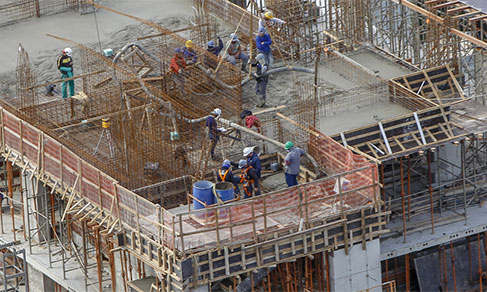PNAD COVID19
28.6 million persons tested for Covid-19 until November
December 23, 2020 09h00 AM | Last Updated: December 29, 2020 11h17 AM
Highlights
- 6.5 million tested positive for the disease.
- After dropping for months, the number of persons who had some symptoms related to the flu-like syndrome changes from 7.8 to 8.0 million.
- 10.2 million persons did not take any restriction measure to avoid the infection by the novel coronavirus.
- Unemployment advances and hits 14 million persons in November.
- In 28.0 million households, some residents received emergency aids.
- 11.2% of the students did not have any school activity in Brazil, being that this percentage was more than twice in the North (25.4%).
- 204 thousand students did not accomplish tasks due to lack of access to the Internet, 169 thousand could not concentrate on the tasks and 154 thousand had no computers,tablets or mobile phones.

The number of persons who made some test to diagnose Covid-19 was 28.6 million until November. Of this total, nearly 6.5 million tested positive for the disease, which corresponds to 22.7% of the persons who tested and 3.1% of the population. Compared with October, more 2.9 million persons were examined and 754 thousand were diagnosed with the new coronavirus. The data are from the last edition of PNAD COVID19, released today (23) by the IBGE.
"Up to November, 13.5% of the population made some test to diagnose Covid-19. The Central-West registered the highest proportion of persons who tested. The tests were also more common among those self-declared white persons, aged between 30 and 59 years, with more schooling years and with higher income," detailed Maria Lucia Vieira, coordinator of the survey.
The most used tests were the SWAB, a procedure in which the material is collected with swabs in the patient´s mouth and/or nose (12.7 million) and the rapid test, in which blood is collected through a finger prick (12.4 million). Other 8.0 million were examined by blood taken out from an arm vein. "The highest percentage of positive tests was registered with the SWAB method (26.6%)," told her.
Among the Federation Units, the Federal District (25.6%) remained leading, with the highest percentage of persons testing in November, followed by Goiás (20.7%), Piauí (20.6%) and Amapá (16.9%). The lowest percentages were recorded in Acre (8.8%), Pernambuco (9.3%) and Alagoas (10.3%).

Symptoms of flu-like syndrome rise once again after dropping for months
Vieira also highlights that the number of persons with some symptom of flu-like syndrome, which had been dropping since June, slightly increased, changing from 7.8 million in October to 8.0 million in November. It corresponds to 3.8% of the population. Cough, fever and breathing difficulties are among the symptoms approached by the survey.
Coupled symptoms, like loss of smell and taste; cough, fever and breathing difficulties; and cough, fever and chest pain also increased. Therefore, the summary indicator points out that 988 thousand persons (or 0.5% of the population) showed coupled symptoms of flu-like syndrome that could be associated to Covid-19. In October, they were 855 thousand persons (0.4%).
According to Vieira, the amount of persons with some symptom who looked for health facilities increased in one month. Although most of them, in absolute numbers, had gone to the public network, a growth in the search for the private network was noticed.
"In November, the search for public health facilities remained stable, after a drop in the search for health centers in October, whereas it increased for private facilities. For example, the search for medical centers or private or military hospitals rose nearly 35% between October (320 thousand persons) and November (431 thousand)," detailed the survey coordinator.
Number of persons who do not follow social distancing rises and surpasses 10 million
The number of persons who did not take any restriction measure to avoid the infection by the novel coronavirus increased 492 thousand in a month, hitting 10.2 million persons, the equivalent to 4.8% of the Brazilian population. Likewise, the group of persons who remained strictly isolated reduced to 23.5 million, less 2.8 million compared with October.
Most of the population (97.9 million) stated to have reduced the contact with other persons, though they remained leaving home or receiving visits, 9.7 million more compared with October. Those who stayed at home and only left it in case of need added up to 79.3 million. This figure reduced by 1.4 million from one month to the other.

Unemployment hits 14.0 million persons
In November, the unemployment rate, measured by PNAD COVID19, hit 14.2%, the highest one in the time series of the survey, started in May. It corresponds to 14.0 million unemployed persons in Brazil; in October, they were 13.8 million.
"The increase in the unemployed population occurred mainly in the Northeast Region. It remained stable in the other regions and dropped in the South," said Vieira, highlighting that this contingent rose 38.6% since May.
The employed population rose to 84.7 million, an increase of 0.6% in relation to October (84.1 million) and, for the first time since the beginning of the survey, it showed a higher contingent than that of May (84.4 million). The employment-population ratio stayed at 49.6%, i.e., less than half of the population at working age was employed.
As a result, the workforce – which corresponds to the employed population plus the unemployed population – increased, adding up to 98.7 million persons. The population out of the workforce reduced to 72.0 million.
"Despite the higher unemployment rate, the employed population got closer to the level of March. It is because we have more persons pressing the labor market searching for a job. These figures reflect the relaxation of the measures of social distancing, with more persons entering the workforce month after month," stated Vieira.
In November, the informality rate stayed at 34.5%, the same as in the previous month, which corresponds to 29.2 million people. The North and Northeast continue with the highest informality rates, 49.6% and 45.2%, respectively.
The survey registered a reduction of 853 thousand persons in the contingent of those who would like to work and did not look for a job due to the pandemic or due to the lack of jobs in the locality where they live (13.6 million).
Of the 84.7 million employed persons, 2.1 million were still away from their work due to social distancing in November. It is the smallest contingent in the time series. In May, 15.7 million were away from their work for this reason.
The number of persons who were working remotely also continued to reduce, reaching 7.3 million. "This indicator is sharply dropping since September, accruing a reduction of 15.8% in the number of persons working remotely since the beginning of the survey, in May," added Vieira.
Some residents received emergency aid in nearly 28.1 million households
The survey also points out that in 41.0% of the households, at least a resident received some emergency aid from the government to face the pandemic in November. This percentage was 42.2% in the previous month. Nearly 28.1 million households were addressed in November against 29.0 million in October. The average value of the benefit received by the population was R$558 per household.
"This percentage reduced in all the Major Regions and in most states," said Vieira, detailing that the regions that have more households with persons receiving emergency aids remained the North (57.0%) and Northeast (55.3%). Among the states, Amapá (70.1%) recorded the highest proportion, followed by Pará (61.1%) and Maranhão (60.2%).
Among the types of aid approached by the survey, the emergency aid, destined to informal workers, individual micro-entrepreneurs (MEI), self-employed persons and unemployed persons, and the supplementation of the Federal Administration through the Emergency Program of Maintenance of Labor and Income stand out.
11.7% of the students did not have school activities in November
PNAD COVID19 also unveils that, of the 46.3 million students, aged between 6 and 29 years, enrolled in schools and universities in November, 5.3 million (11.7%) did not have any school activity. Most of them, 39.5 million (87.5%), had a task at least once a week. The remaining ones were on vacation (0.8%).
Among the students who had activities, but did not accomplish tasks, 204 thousand (28%) alleged lack of access to the Internet or insufficient quality as the reason, 169 thousand (23.2%) stated that they could not concentrate on the tasks and 154 thousand (21.2%) did not have any computer, tablet or mobile phone available to access the tasks.
In the North, 25.3% of the children, teenagers and youngsters who attended school had no access to the school activities, followed by the Northeast (17.1%). The South (3.7%), Southeast (7.9%) and Central-West (6.0%) recorded the lowest percentages. In the public education network of Bahia, 38.2% of the students did not have any task, the highest percentage among the Brazilian states.
PNAD COVID19 brought advances for IBGE surveys
In this last edition of PNAD COVID19, Vieira reminds that the survey, which comprises the IBGE´s Experimental Statistics, was planned so as to its results were released for a period of three to four months, yet it was extended for seven months.
"We decided to quit the survey because we were working with the same households for seven months. It bothers the informants and increases the refusal. Yet we believe that PNAD COVID19 fulfilled its role of portraying the country in a very difficult moment for everybody," said the coordinator of the survey.
Vieira also highlights that the survey brought advances in the method of collecting data through telephone and it was also an innovation as it released data on a weekly basis. "We were able to quickly follow up the evolution of the effects of the pandemic on the labor market and on the health of the population. This was something that the IBGE had never done with any household survey," concluded her.




















